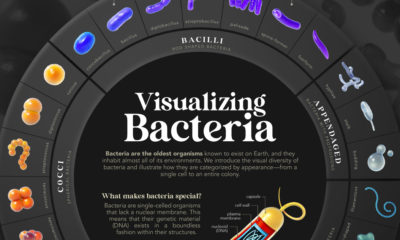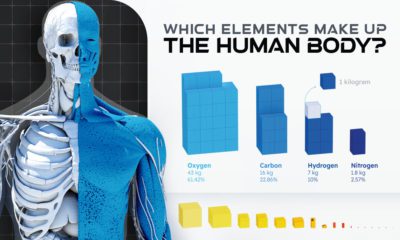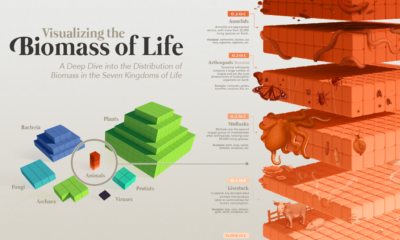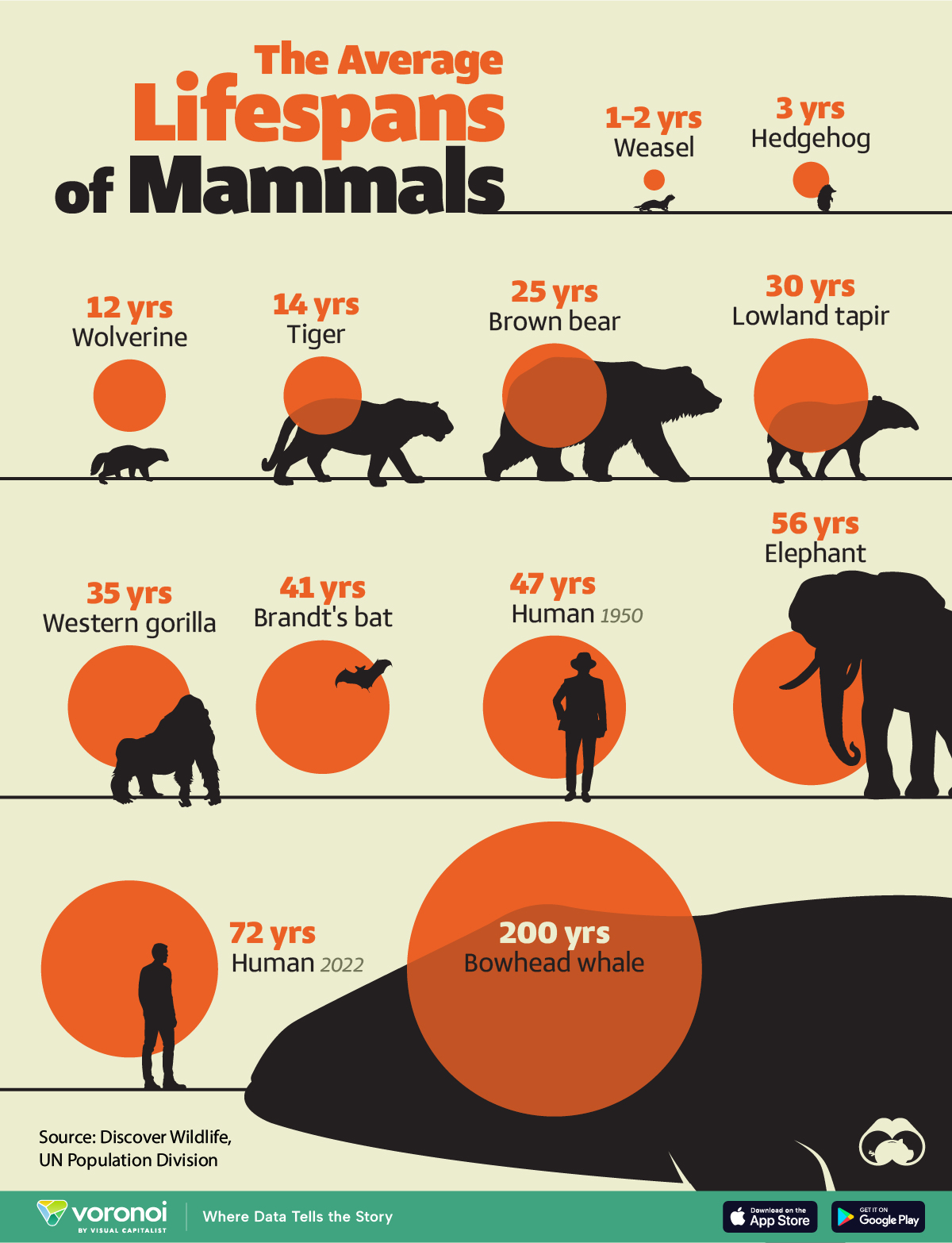Science
Visualized: What Lives in Your Gut Microbiome?
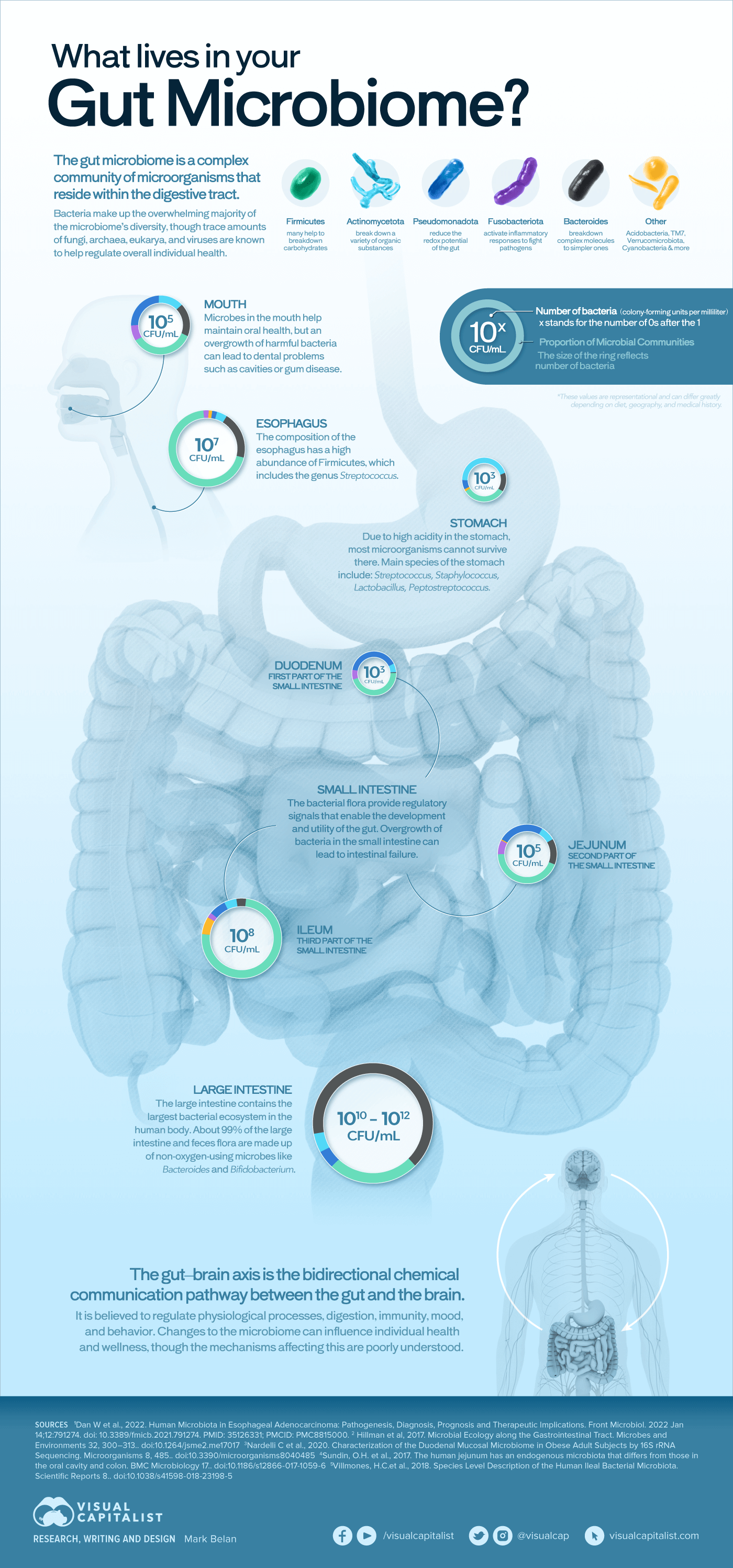
Visualized: What Lives in Your Gut Microbiome
Inside all of us lies a complex ecosystem of microbes. It includes bacteria, fungi, and even viruses that live in virtually every part of our bodies.
Researchers are continuing to discover how deeply connected our overall gastrointestinal health—gut health—is to these microbes.
Because bacteria outnumber all other microbes, we take a look at which ones live inside of us and what they do.
The Bacteria of the Gut Microbiome
The gut microbiome is composed of six main types of microbes. Each of these types of microbes has a unique function and role within the human body:
- Firmicutes: Firmicutes break down complex carbohydrates and produce short-chain fatty acids for energy. They help maintain the functioning of the gut barrier, which obstructs bacteria, harmful microorganisms, and toxins from entering the bloodstream through the intestinal tracks. Firmicutes are also linked to obesity and metabolic disorders when imbalanced.
- Actinomycetota: Actinomycetota break down complex carbs and produce vitamins B12 and K2, which are crucial for calcium absorption and energy generation in the body. They also protect the gut from harmful pathogens.
- Pseudomonadota: Pseudomonadota lowers the gut’s redox potential, a measure of the balance between oxidants and antioxidants in the gastrointestinal tract. This is important for breaking down, storing, and using energy. They do this by producing short-chain fatty acids and breaking down complex molecules, promoting the growth of other beneficial gut microbes.
- Fusobacteriota: Fusobacteriota can activate inflammatory responses to fight pathogens. But when imbalanced, they can contribute to inflammation and disease, such as periodontal disease.
- Bacteroides: Bacteroides break down complex carbohydrates, regulate the immune system, and produce vitamins and metabolites important for overall health in the human gut microbiome.
- Other: The “other” category includes a diverse range of microbes that contribute to various functions within the gut. These include various types of bacteria including TM7 (oral bacteria), cyanobacteria, acidobacteria, and verrucomicrobiota.
Dynamic Composition of the Microbiome
Interestingly, the proportions of these six microbe populations vary throughout the gastrointestinal tract.
| Section of Gut Microbiome | Exponential Microbial Population (CFU/ml) | Dominant Microbe |
|---|---|---|
| Mouth | 10⁵ | Firmicutes |
| Esophagus | 10⁷ | Firmicutes |
| Stomach | 10³ | Actinomycetota |
| Duodenum (Small Intestine) | 10³ | Firmicutes |
| Jejunum (Small Intestine) | 10⁵ | Firmicutes |
| Ileum (Small Intestine) | 10⁸ | Firmicutes |
| Large Intestine | 10¹⁰-10¹² | Bacteroides |
The presence, absence, and dominance of each of these microbes is based on their functionality. For example, in the mouth and esophagus, the microbial populations are relatively low. But the dominant microbe found here, Firmicutes, helps begin the process of breaking down sugars and carbohydrates from ingested food.
Meanwhile, the stomach is a harsh environment, with low pH levels that limit microbial growth. A small population of microbes is still present here.
The microbial population becomes more diverse in the small intestine. Here, Firmicutes and Actinomycetota are the dominant species, but Bacteroides and other microbes begin to make up a more substantial portion of the population.
The microbial population further diversifies in the large intestine, with Bacteroides and other microbes making up the majority of the population.
These proportions of bacteria in the gut microbiome represent the typical ratios for the average human body. But they can be influenced by factors including medical history, diet, age, and even geographical location.
The Gut-Brain Axis
The six microbe populations have effects way outside the gastrointestinal tract too.
The Gut-Brain Axis is a two-way link between the gut and the brain. This connection involves physical pathways and various forms of communication, including hormones, metabolism, and immunity.
Through these connections, the gut sends the brain signals when troubled. A distressed stomach or intestine is linked to anxiety, stress, depression, and other mental health issues. Irritable bowel syndrome (IBS) is another example of a disease influenced by the gut microbiome.
At the same time, the brain also signals the gut when distressed. Scientists believe that emotions like anger, anxiety, sadness, and happiness trigger gut issues.
Towards a Healthy Gut
The gut is known as our body’s “second brain” and more and more people are now paying close attention to their gut health.
Over the last two decades, we’ve gained a better understanding of how the microbiome affects human health. One example of this is the gut-brain axis. Changes in the microbiome have also been connected to various diseases.
Understanding this microbiome has opened up new opportunities in medicine and healthcare, as the knowledge of the role of every microbe could also uncover new treatments for illnesses linked to it.
Science
Visualizing the Average Lifespans of Mammals
While smaller animals such as weasels typically live 1-2 years, larger counterparts can thrive for decades.
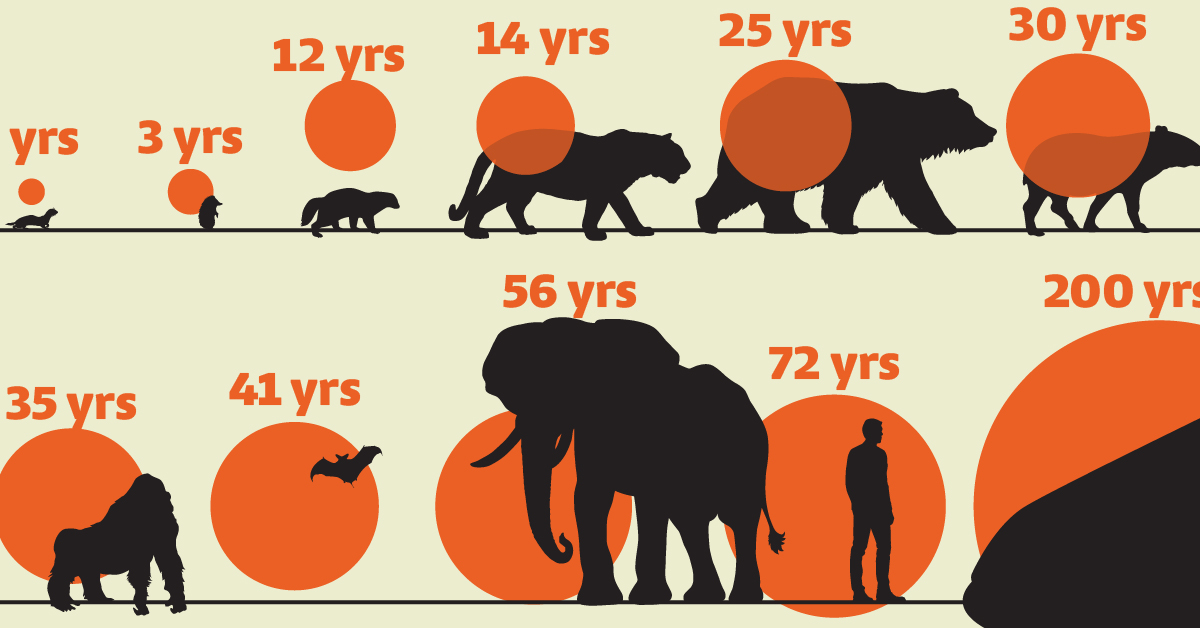
Visualizing the Average Lifespans of Mammals
This was originally posted on our Voronoi app. Download the app for free on iOS or Android and discover incredible data-driven charts from a variety of trusted sources.
Mammals, though comprising a small fraction of Earth’s creatures, hold vital ecological roles globally. They are crucial for maintaining ecosystem health through services like pollination, seed dispersal, and predator-prey dynamics.
In this visualization, we depict the average lifespans of mammals, using data from Discover Wildlife and the United Nations.
Human Lifespans on the Rise
Defined as warm-blooded creatures with hair or fur, mammals nurse their young with milk from mammary glands. While smaller animals such as weasels typically live 1-2 years, larger counterparts like elephants can thrive for decades, and bowhead whales can live for 200 years, or even longer.
| Animal | Average lifespan (years) |
|---|---|
| Weasel | 1 to 2 |
| Hedgehog | 3 |
| Wolverine | 12 |
| Tiger | 14 |
| Brown bear | 25 |
| Lowland tapir | 30 |
| Western gorilla | 35 |
| Brandt's bat | 41 |
| Humans (1950) | 47 |
| Elephant | 56 |
| Humans (2022) | 72 |
| Bowhead whale | 200 |
Notably, human lifespans have experienced a remarkable surge. According to the UN Population Division, the global average life expectancy has surged from 47 years in 1950 to 72 years in 2022, marking a 25-year increase. This is attributed to advancements in nutrition, medication, and essential resources.
However, as human longevity flourishes, it can have an adverse effect on wildlife mammal populations. To put this into numbers, over the past 100,000 years, the surge in human population has precipitated an 85% reduction in wild mammal biomass.
Today, livestock dominates 62% of the world’s mammal biomass, with humans accounting for 34%, while wild mammals comprise only 4%.
Despite a decline in mammal diversity, the total biomass of terrestrial mammals has significantly increased, expanding approximately ninefold over the past 10,000 years.
Curious to learn more about mammals? Check out this graphic that shows the biomass of all the world’s mammals.
-

 Education1 week ago
Education1 week agoHow Hard Is It to Get Into an Ivy League School?
-

 Technology2 weeks ago
Technology2 weeks agoRanked: Semiconductor Companies by Industry Revenue Share
-

 Markets2 weeks ago
Markets2 weeks agoRanked: The World’s Top Flight Routes, by Revenue
-

 Demographics2 weeks ago
Demographics2 weeks agoPopulation Projections: The World’s 6 Largest Countries in 2075
-

 Markets2 weeks ago
Markets2 weeks agoThe Top 10 States by Real GDP Growth in 2023
-

 Demographics2 weeks ago
Demographics2 weeks agoThe Smallest Gender Wage Gaps in OECD Countries
-

 Economy2 weeks ago
Economy2 weeks agoWhere U.S. Inflation Hit the Hardest in March 2024
-

 Green2 weeks ago
Green2 weeks agoTop Countries By Forest Growth Since 2001
